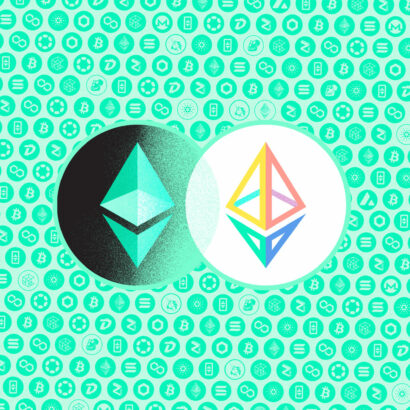Solana feels like a cryptocurrency from a futuristic society.
Like in the cult classic Demolition Man (1993), where money as we know it is not really a thing anymore. Characters in this dystopian future use a monetary system called “credits”, which is both electronic and instantaneous.
Transactions on Solana are almost instantaneous and with incredibly low transaction fees it’s a viable competitor for fiat credit card transactions. With its smart contract capabilities, utilities like non-fungible tokens (NFTs) can also be built on Solana. Low transaction fees alone are drawing in a lot of retail investors, developers and artists onto its platform. Basically, it’s Ethereum but faster and cheaper.
Despite outages and some technical issues, SOL is one of the top cryptocurrencies by market cap. In 2021 we saw Solana rise from $0.50 all the way up to $259 USD as of November 2021.
However, like almost everything else in the cryptoverse, it fell dramatically in the first part of 2022, seeing lows fall to under $50 by June 2022.
The Promise of Solana
Problem:
High Transaction Fees
As the cost of transaction fees for Ethereum continue to rise, a person might need to spend more than $200 to buy or sell a single NFT. Often, the cost of the transaction can be higher than the price of the NFT itself, ensuring that only those able to pay a premium can participate in the ecosystem.
If you can afford these exorbitant fees, the transaction still takes 30 seconds and sometimes longer to process. In that time, someone paying a premium transaction fee could snatch up your favorite NFT first, making you spend $200 in fees for nothing! Gas fees aren’t refundable regardless of whether the transaction fails.
Even the Polygon network, developed as a low-fee alternative to Ethereum, is struggling as the prices of transaction fees continue rising.
Solution:
Solana’s Fast and Cheap Blockchain Verification
Solana is designed to tackle real-world problems, processing more than 50,000 transactions per second to keep transaction costs low. That means it makes decentralized-finance (DeFi), which involves multiple transactions, cheap even to a retail investor with $100 in SOL. Building out an ecosystem to the real world will mean easier ways for us to invest our crypto into savings accounts, and cheaper ways to buy and sell NFTs.
Equity:
The Blockchain Should be for Everyone
While many different cryptocurrencies promise a more equitable financial system, transaction fees give an unfair advantage to larger investors. To make finance more fair, Solana makes it just as cheap and quick for you to process your transaction, whether you own 1 SOL or 10000 SOL.
SOL – Possibly the worst coin symbol in all of crypto.
– Mark
A Brief History of Solana
Solana was founded in March 2017 by former executives from Qualcomm, opening up the blockchain to the public in 2021. The parent company Solana Labs, received a rush of investments totalling an impressive $314 million just in the summer of 2021.
Founder Anatoly Yakovenko believes that Solana’s key innovations for speeding up verification of transactions make it the first scalable blockchain.
Solana’s release and adoption in the crypto space occurred in the wake of Ethereum’s DeFi rush, where investors were looking to earn interest and loan out their crypto. However, Ethereum proved it couldn’t handle the congestion which resulted in slowed transaction times and higher fees. Solana responded accordingly by building a blockchain with an average transaction fee of $0.00025.
By developing a method of verification that uses the Proof of History protocol, Solana can speed past Ethereum and other blockchains. While The Flash receives his speedy super powers from something called “the Speed Force”, Solana goes fast because of PoH.
How Does Solana Work?
Solana uses a modified form of Proof of Stake validation, combined with Proof of History. Proof of Stake requires any potential validators to put up some SOL, to earn rewards for validating new transactions. Any fraudulent activity and the SOL that you staked is lost; while this method disincentivizes fraud, it normally isn’t lightning fast.
Solana’s version of Proof of Stake uses a Tower Consensus, a system that uses distributed networks to reach a consensus. Each transaction comes with a timestamp, creating a Proof of History. Like photographs of dye diffusing in a beaker, it is easy for the blockchain to tell which events occurred first because of these cryptographic timestamps.
The Tower Consensus uses a synchronized clock across all the nodes so that it doesn’t need as much power to process new transactions. Since everything is timestamped, it is fairly easy to string transactions together, verify that they are legitimate and add that snapshot to the blockchain.
Milestones and Developmental Stages
As of Q4 2021, Solana has a market cap of close to $60 billion and a circulating supply of close to 300 million tokens. The total supply is set to grow and shrink based on community discussions.
That means for the first few years, the total amount of tokens will increase 8%, followed by a lull where tokens are burnt leading to a final long-term inflation rate of 1.5%. More tokens can be earned by staking SOL, receiving rewards for helping verify transactions.
In less than two years, the price of Solana has jumped roughly 28,000%, going from around $0.50 in May 2020 to hitting a high of more than $180 in September 2021. Even if its rate of growth slows significantly, it is still in position to overtake Ethereum. Without significant changes to reduce the cost of Ethereum transactions, Solana may continue to dominate.
The Easiest Way to Buy and Store Solana
Finding the best exchange to offload your hard-earned fiat cash into crypto can be difficult. It sometimes makes sense to find a few exchanges you are comfortable to use, and stick with them. While larger exchanges may have higher fees, they also often have proven track records and reliability.
Comparing three of the best exchanges:
| Exchange | Newton | Coinbase | Crypto.com |
| Ease-of-Use | ✔✔✔✔✔ | ✔✔✔✔✔ | ✔✔✔✔✔ |
| Trading Fees | None | Variable depending on transaction; high fees | Lower fees than Coinbase |
| Payment | E-transfer or wire transfer | Debit or Credit Card | Debit or Credit Card |
| Recurring Buys | No | Yes | Yes |
| Notes | Covers gas up to $5 (move to your wallet for free) | Offers the opportunity to earn various crypto for free through learning rewards | Promotion, when you join, waives fees for 30 days |
| Security & Reputation | Cold storage of assets
FINTRAC#M19607029 |
Strong reputation and track record
FDIC Insured |
Strong reputation and track record
FDIC Insured |
Storing Solana
After you purchase SOL from an exchange, you can keep it on the exchange if you trust it, or move it to a wallet that you own. We recommend moving your SOL to your own wallet so that you can participate in staking and earn rewards.
You wouldn’t want a company that you don’t trust to hold onto your soul, and for that very same reason many of us choose to move SOL to our own wallet. This gives you the access key to your own SOL, but unfortunately does not give you keys for a Kia Soul.
If you plan to use and exchange your SOL or participate in DeFi and the NFT market, you might want to keep it stored in a hot wallet, software designed to store your crypto on your phone or desktop. Nowadays many cold wallets also allow you to use these very same wallets to store your crypto but they come with the extra security of being off-line until you decide to connect them.
The best way to secure your cryptocurrency online is through the use of a cold wallet. This wallet is hardware that you can plug and unplug from your computer. It looks like a USB or small hard drive, and as long as it’s not connected to a computer, your crypto is safely stored.
These are some of the best wallets available for storing SOL. Note that the Trezor cold wallet does not currently support Solana.
| Type of Wallet | Hot | Cold | ||
| Name | Exodus | Phantom | Solflare | Ledger |
| Platforms | Windows macOS, Linux |
Browser app | Windows macOS, Linux |
Connects via USB |
| Supported Wallets | Exodus
Phantom Solflare |
|||
| Mobile App | Yes | No Only available as browser extension |
Yes | No |
| Initial Setup | Instant | Instant | Instant | 10 – 15 mins |
| Private Keys (held by you) |
Yes | Yes | Yes | Yes |
| Staking | Yes | Yes | Yes | Yes |
Staking Solana
Staking on Solana may require you to create a new account to which you send the tokens that you will stake. You are given a choice of different validators, allowing you to pool your Solana with other users, delegating your staking to a single node.
Find a validator with a low commission, this means they take very little of the stake reward for themselves. However, if your validator engages in malicious or fraudulent behavior, the pool will be slashed, with everyone contributing to that validation node losing a portion of their stake.
The easiest way to stake SOL is to use wallet (like Exodus) to stake your SOL and earn 6-7% APY.
The Case for Investing in SOL
Solana solves the problems that prevent blockchains like Ethereum from adoption. It’s lightning quick speed and ability to process 50,000 transactions per second cannot currently be matched. While Ethereum may upgrade their system in the future, at the moment it is much slower and has much higher transaction fees. In contrast, Solana’s transaction fees will likely not exceed $0.01.
In less than two years of operation, Solana has grown an absurd 28,000%!! It’s so much faster than competitors. Which makes it a relatively safe investment for now. However, it’s important to note that with such a steep incline, there is also potential for volatility and a future drop in its price. Keep your eyes on the ticker, wait for the price to drop significantly — that’s your best time to buy in.
Disadvantages of SOL?
All in all, there are no significant red flags.
- Solana’s main disadvantages lies in its relatively centralized architecture. Compared to other blockchains, there are much fewer nodes.
- Additionally, many decentralized apps have yet to be deployed on Solana so it is unclear whether they will succeed.
- Finally, the cost of setting up hardware to build Solana applications is costlier.
Conclusion
Despite being fairly new to the scene, Solana blows Ethereum and other major blockchains out of the water by processing 50,000 transactions per second with an average fee of $0.00025. By using timestamps and Proof of History along with Proof of Stake, it is able to stay fast and efficient.
With Smart Contracts, NFTs and more applications on the horizon, it could catch up to Ethereum, especially if ETH 2.0 doesn’t launch smoothly or on time.
Solana, like The Flash, doesn’t quite get the respect and recognition that it deserves but it’s starting to. In our opinion, it’s worth considering buying some SOL, but it’s hard to imagine another year with exponential growth like 2021.
You can always stake your SOL and earn around 6-7% APY — keep HODLing and wait as the value increases.




